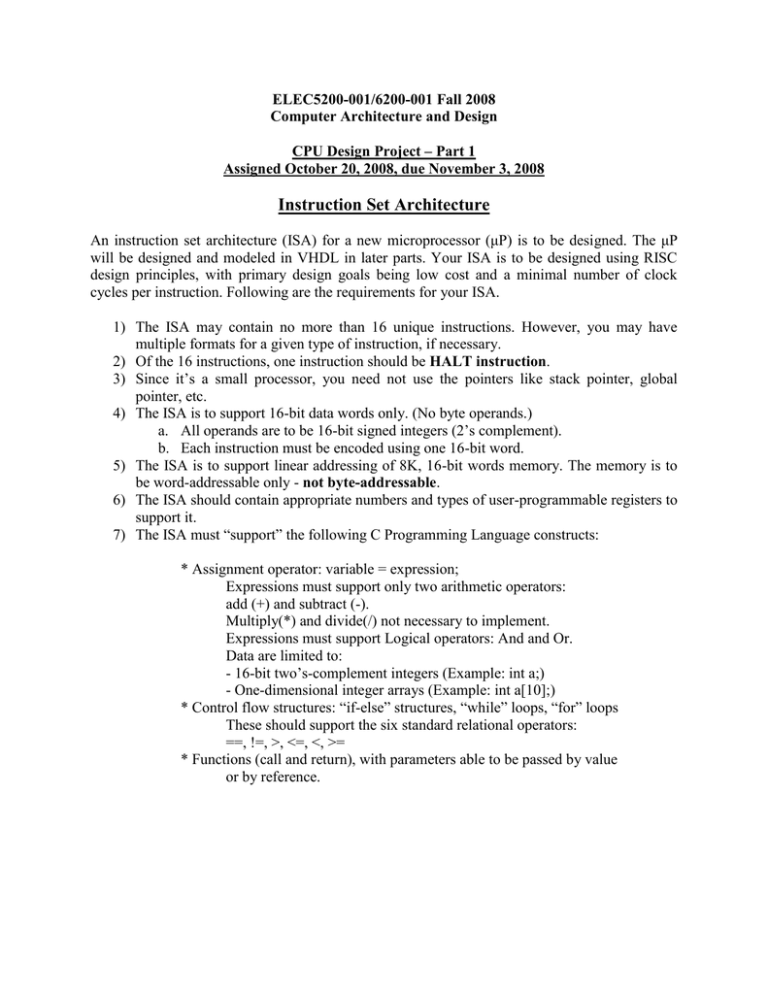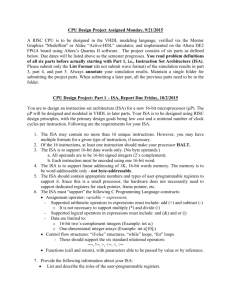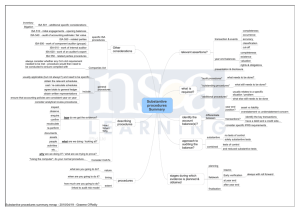ELEC5200-001/6200-001 Fall 2008 Computer Architecture and Design
advertisement

ELEC5200-001/6200-001 Fall 2008 Computer Architecture and Design CPU Design Project – Part 1 Assigned October 20, 2008, due November 3, 2008 Instruction Set Architecture An instruction set architecture (ISA) for a new microprocessor (μP) is to be designed. The μP will be designed and modeled in VHDL in later parts. Your ISA is to be designed using RISC design principles, with primary design goals being low cost and a minimal number of clock cycles per instruction. Following are the requirements for your ISA. 1) The ISA may contain no more than 16 unique instructions. However, you may have multiple formats for a given type of instruction, if necessary. 2) Of the 16 instructions, one instruction should be HALT instruction. 3) Since it’s a small processor, you need not use the pointers like stack pointer, global pointer, etc. 4) The ISA is to support 16-bit data words only. (No byte operands.) a. All operands are to be 16-bit signed integers (2’s complement). b. Each instruction must be encoded using one 16-bit word. 5) The ISA is to support linear addressing of 8K, 16-bit words memory. The memory is to be word-addressable only - not byte-addressable. 6) The ISA should contain appropriate numbers and types of user-programmable registers to support it. 7) The ISA must “support” the following C Programming Language constructs: * Assignment operator: variable = expression; Expressions must support only two arithmetic operators: add (+) and subtract (-). Multiply(*) and divide(/) not necessary to implement. Expressions must support Logical operators: And and Or. Data are limited to: - 16-bit two’s-complement integers (Example: int a;) - One-dimensional integer arrays (Example: int a[10];) * Control flow structures: “if-else” structures, “while” loops, “for” loops These should support the six standard relational operators: ==, !=, >, <=, <, >= * Functions (call and return), with parameters able to be passed by value or by reference. Provide the following information about your ISA: 1) List and describe the user-programmable registers. 2) List and describe the different instruction formats used. 3) For each instruction in your instruction set, list the following: Assembly language for each form of the instruction - mnemonic and operands Machine language for each form of the instruction: instruction code format, op-code, and operand encoding Justification for including each form of the instruction in your ISA 4) For each C construct listed in item 6 above, provide an example showing how the construct would be “compiled”, i.e. implemented with your instruction set, by writing an example of the C construct and the corresponding assembly language (AL) implementation. Program: 1) Using the ISA you have designed, write a program to multiply two 16-bit 2’s complement integers by successive addition. 2) Your program should be able to multiply positive or negative numbers. 3) The hardware (ALU) should have a provision to indicate overflow error when the multiplication result exceeds the maximum value that can be represented using 16 bits. This is ‘minimum’ what the processor is supposed to do. You are free to choose your own program for demonstration during final part of the project and design ISA accordingly.


